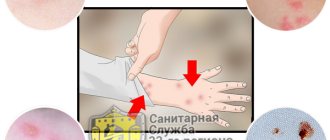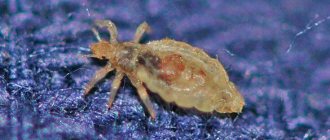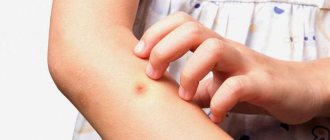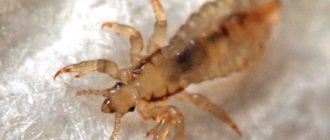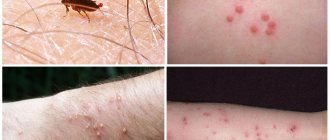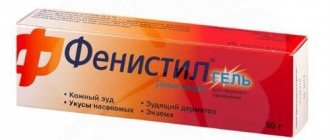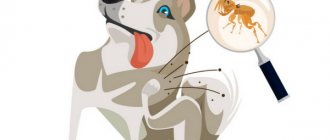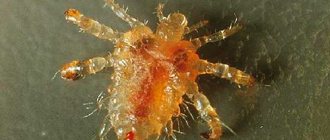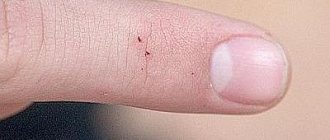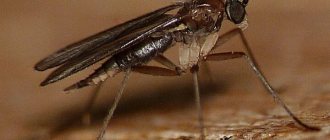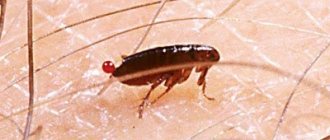Only those who are lucky enough to avoid contact with fleas firmly believe in their harmlessness to humans. The opinion is erroneous, because blood-sucking animals have long been established in everyday life and parasitize not only domestic animals, but also their owners. Flea bites are quite painful, but this is not the biggest nuisance after an insect attack.
Armed with a special tool for piercing human skin, bloodsuckers are capable of infecting a dangerous disease and causing a serious allergic reaction. To protect yourself from possible complications, it is important to learn to recognize the consequences of a flea attack and learn the rules of first aid.
Who are fleas and how do they bite?
To date, more than 2 thousand species of fleas have been studied, divided into 200 genera and 15 families. Moreover, they all look the same, so the uninitiated are unlikely to distinguish representatives of different families by their appearance.
Translated from Latin (Siphonaptera), the name of the insect consists of two words: “wingless”, “pump”. The mouthparts of the brownish parasite actually resemble a pump equipped with a tool for piercing the skin of the victim. After the puncture, the insect sticks its head into the wound and releases a small amount of a special enzyme that prevents blood clotting. Since flea saliva does not contain painkillers, the insect bite is painful, reminiscent of a needle prick.
Due to the spines located on the chitinous shell, the flea easily clings and moves in the fur, feathers, and hair of the owner. Thanks to its developed limbs, the insect can move by jumping, up to 30 cm in height and up to half a meter in length. The length of the blood-sucking insect rarely exceeds 5 mm, so the insect, covered with a durable shell, is almost impossible to catch, and even more difficult to crush.
Interesting fact! The insect is distinguished by incredible jumping ability and endurance. A tiny flea can carry a load 160,000 times its own weight, jump 150,000 times its own height, more than 30,000 times in a row. Moreover, a year of living in low temperatures in no way affects the viability of the insect.
Can fleas bite humans?
In most cases, fleas parasitize at the expense of humans only when there are no animals nearby. And the point is not that the blood of a cat or dog is tastier - insects are unpretentious in this matter. It's all about the wool or feather cover, which provides the bloodsucking creatures with the most comfortable existence.
Often, flea bites appear in those people who simply got in their way first. And pet owners especially often find itchy, painful spots on their legs.
However, some varieties of fleas appear regardless of whether there is an animal in the house or not. The following types of fleas can be found especially often:
- Dog and cat. The animal can bring both of them from a walk. Insects jump on the floor and happily switch to human blood.
- Chicken ones - you can “pick them up” after going to the chicken coop. Poultry becomes infected after contact with wild birds.
- Ratidae, parasitic on rats and mice. It is believed that it was this type of flea that marked the beginning of the terrible plague epidemic that arose in the 14th century, killing more than 25 million people.
- Human - Domestic flea bites are characterized by very painful bites and can live on both humans and animals.
- Earthen (basement) - live in the upper layers of the soil. Once in a person’s home, they occupy carpets, furniture upholstery, and areas behind the baseboards. The bites of earthen (basement) fleas are localized under the nail plate, where the females lay their eggs. The bite site itches, swells, and festers.
- Sandy - live in the sand, mainly in coniferous forests. Unlike its relatives, the sand flea does not just bite, it penetrates the skin and lives there.
- Bed fleas live in bedding and furniture upholstery. Bed flea bites occur in the dark.
Having discovered flea bites on their body, many people let the situation take its course, without even thinking about the possible danger. It is important to understand that swollen areas of the body covered with red spots are just the tip of the iceberg. The main danger lies in the ability of insects to transmit deadly infections: typhoid, salmonellosis, encephalitis, etc.
Chemicals
In their work, exterminators use chemicals:
- Xulate C25;
- Fendon;
- Eslandez;
- Avefors.
Insecticidal powder
Powder with an insecticide kills not only adults, but also larvae, and this is especially important when ridding a home of parasites. The powder penetrates into small cracks, between carpet fibers and other places where females lay eggs. The Russian insecticide Phenaxin has gained popularity among the population. It is non-toxic, economical, easy to use and quite effective.
Aerosol
Substances based on organic phosphorus are considered more effective. Aerosols are able to penetrate hard-to-reach places, but they are powerless where the number of fleas is too large.
Carrying out wet treatment with insecticide
Wet treatment with an insecticide is carried out as a preparatory measure before carrying out pest control.
Flea sprays
Dichlorvos and Karbofos are already outdated, but successfully continue their fight against parasites. Karbofos contains dust powder, so you need to work with it strictly wearing gloves. Aerosol Raptor based on tetramethrin and cypermethrin is completely safe for humans. Once in the body, these substances are broken down by enzymes without causing harm.
Solutions against parasites
Liquid solutions look like small capsules with concentrated poison inside. They must be diluted in water and wet cleaned with this product.
Why do fleas appear in an apartment?
A flea, first noticed in a clean, tidy house, causes extreme bewilderment and displeasure of the owners. This reaction is explained by people’s confidence that parasites appear only in unsanitary conditions. And yet, if you have a pet, you can suspect that the parasites were brought from a walk.
The situation becomes especially unclear when there are no pets in the apartment, but fleas appear. However, experts say that in most cases, a flea is a causeless, random and unexpected phenomenon.
Very often, if we are talking about a private house or an apartment located on the ground floor, insects enter through basements or directly from the street. A little less often, fleas enter an apartment through windows, doors, ventilation, cracks in the walls, and joints of water pipes.
So, let's look at the main ways parasites get into your home:
- from neighboring apartments: through loggias, balconies, thresholds when the door is open;
- from basements (the damp warmth of basements is the best environment for flea breeding);
- from attics or technical floors;
- with dirty shoes;
- from adjacent non-residential premises: supermarkets, warehouses;
- on the fur of a pet after a walk;
- on the fur of rodents that enter a person’s home with the onset of cold weather (especially important for private homes).
Attention! Even one flea found in an apartment is a reason to contact an exterminator. A person sees only 1 flea out of 100 living ones, because for each adult there are many pupae, larvae and eggs.
Preparing the premises
An important condition for achieving a good result is careful preparation of the room for processing. All unnecessary old things and garbage should be thrown away. It is advisable to vacuum the floor. It is recommended to knock out carpets. In addition, be sure to treat all surfaces with soapy water.
Furniture should be immediately coated with special agents that repel parasites. Products must be refrigerated during disinfection to prevent chemicals from coming into contact with them. After this, you should close all windows tightly and begin processing the room.
Signs and symptoms of flea bites
Flea bites are always accompanied by pain, which the affected person characterizes as a needle prick. An enzyme injected into the wound by insects causes itching, swelling and redness of the affected area. As a rule, flea bites are accompanied by local reactions noticeable on the human body:
- The attack is accompanied by sharp pain, because unlike other parasites, during the bite the insect does not release an anesthetic substance.
- Immediately after an insect bite, a swollen red spot remains on the body.
- For several hours, the victim experiences serious discomfort due to the itching and burning sensation.
- The puncture point is not visible, but a speck of blood appears at the site of the bite. If there are many bites, extensive hemorrhages (bruises) form around the wounds.
- Flea bite marks are located in groups of 2–3 spots with a distance of 1–2 cm between them.
- To a greater extent, insects live on the floor or baseboards, so in most cases the legs are affected: legs, feet.
Attention! Scratching the wound can lead to infection.
For allergy sufferers, blood-sucking saliva can cause a noticeable deterioration in well-being: difficulty breathing, increased body temperature, gastrointestinal upset, swelling of the lips. Without timely medical care, swelling of the larynx, suffocation, and death can occur. But even an absolutely healthy person can develop a condition resembling an allergic reaction - pulicosis. It manifests itself:
- continuous rash;
- inflammation, suppuration of wounds;
- ulcerations in the oral cavity;
- enlarged lymph nodes;
- increased temperature;
- headache.
Having discovered characteristic signs of a flea attack on your body, you need to carefully inspect your home, paying special attention to baseboards, carpets, and animal bedding (if any). If your fears are confirmed, you should see a specialist and find out what to apply to flea bites.
When to see a doctor
A flea bite on a person, a photo of which demonstrates possible variations in its manifestation, may be a reason to contact a medical facility if the following symptoms are present:
- long-lasting spots and regular itching;
- an increase in the area of irritation and the growth of spots into ulcers;
- the appearance of pus on the wounds;
- the occurrence of ulcerations on the mucous membranes of the oral cavity;
- the appearance of weakness in the body, dizziness;
- fever, chills and increased temperature;
- severe swelling at the bite site;
- the occurrence of attacks of suffocation, a feeling of laryngeal congestion;
- inflammation of the lymph nodes.
The initial examination is carried out by a therapist, who, based on the results of the examination, will prescribe diagnostic measures and, if necessary, give a referral to another doctor: a dermatologist, otolaryngologist, surgeon, gastroenterologist, neurologist.
What infections can fleas carry?
The insects themselves cause severe skin lesions - sarcopsillosis and pulicosis. However, by feeding on the blood of an infected victim, fleas become carriers of more than 25 dangerous infections (and the viability of pathogenic microbes in the parasite’s body remains for a year).
The 10 most dangerous include:
- tularemia;
- encephalitis;
- anthrax;
- plague;
- typhus;
- salmonellosis;
- listeriosis;
- hepatitis;
- brucellosis.
Why are flea attacks dangerous?
A single flea bite does not pose a serious threat to human health. But with systematic attacks by “bloodsuckers”, the following complications can develop:
- Unbearable itching and burning of the affected areas of the skin. This in itself is not a complication. The danger of infection lies only in those who furiously scratch the bite sites.
- Mental or neurological disorders (a person is constantly attacked by imaginary insects).
- Acute allergic reactions, dangerous in their rapidity, which can be complicated by Quincke's edema and anaphylactic shock.
- Infection of the body with helminths.
- Damage to the body by toxic substances from flea saliva.
In addition, fleas living on sick or dead animals can carry parasitic worms and fungal infections. Zoonotic infections (tularemia, listeriosis, brucellosis) “borrowed” by insects from animals pose a significant danger. Such diseases are difficult to diagnose and almost impossible to cure.
Specifics of behavior
Fleas jump well, easily covering distances of up to 50 cm. Parasites most often move along areas of the skin covered with hair, but they cannot stay in one place for a long time.
Having drunk the blood of their victim, the pests hide in secluded corners of the house and lay eggs. In an apartment, fleas most often hide in the following places:
- in the cracks of baseboards, trim, window sills;
- in a rug located near the front door;
- in folds of furniture, soft toys;
- in closets with clothes and bed linen;
- in animal bedding, bird cages;
- in the bathroom, sinks.
Organic dust particles or excrement of adults are sufficient to feed the hatched larvae.
What does a flea bite look like?
By examining the mark of a flea bite, you can guess what type of insect attacked. Rat or cat fleas leave tiny sores that resemble allergic rashes. Inhabitants of large animals leave painful swellings that resemble bee stings.
Regardless of the type of parasite that bites, the affected area appears as a tiny red dot, around which a halo of reddened skin forms. Redness lasts from 2 to 48 hours . If an allergy develops, the local reaction does not disappear for several weeks.
What is the difference between a flea bite and other bloodsuckers?
Mosquitoes, linen lice or bedbugs can attack a person right in his home. Moreover, the bites left by bloodsuckers are easily confused, which means that the likelihood of erroneously identifying the pest is quite high. But, although flea marks on the human body resemble wounds left by other parasites, they have characteristic differences:
- a flea attack is always accompanied by sharp pain (insect saliva does not contain an anesthetic);
- the presence of subcutaneous hemorrhages;
- the wounds are located randomly, with 2–3 spots next to each other;
- the main affected area is the lower limbs (fleas rarely attack open areas of the body).
This is interesting! To identify the elusive "criminals", you can take a sheet of white paper and place it in the place where someone is biting. After some time, black dots will appear on a white background, disappearing at the slightest vibration of the sheet. These are fleas.
Comparison of flea and bedbug bites
There are several signs that allow you to distinguish a flea bite from a bug bite:
- Fleas bite the lower limbs, and bedbugs bite the entire body.
- Fleas bite randomly, and bedbugs make paths.
- Fleas attack at any time of the day, and bedbugs attack at night.
- A flea bite resembles a needle prick, and the bug attacks painlessly.
Use of medications
After a flea attack, you need to provide first aid to the victim:
- Using warm water and laundry soap, wash off the remaining insect saliva and feces;
- treat the wound with brilliant green, hydrogen peroxide, alcohol or vodka;
- apply a cold compress to prevent swelling of the skin, relieve itching and pain;
- lubricate the affected area with anti-bite cream/ointment;
- Give the victim any antihistamine to promptly stop the development of an allergic reaction.
After providing first aid, you need to act according to the situation: if up to 6 bites are noticeable on the skin, and the person does not suffer from allergies, medical attention may not be needed. In all other cases, the victim must be shown to a doctor. A specialist will conduct an examination and tell you how to treat flea bites correctly.
Pharmacy drugs
The doctor prescribes pharmaceuticals depending on the severity of symptoms, the person’s age, and the extent of the lesion. Most often, flea bites on humans are treated with the following medications:
Fenistil gel
A unique product that allows you to quickly and effectively relieve itching, redness and swelling. Often prescribed to treat allergic rashes. Used 2–4 times a day. Contraindicated for infants, as well as for the treatment of large areas of skin for young children.
Hydrocortisone ointment
A potent hormonal drug that has many side effects, therefore it is prescribed only in emergency cases. The ointment is indispensable for severe consequences of a flea attack, when “softer” medications have proven to be ineffective.
The drug quickly eliminates all symptoms of the bite. It is not used for pregnant women and children of the first year of life.
Balm “Star”
A time-tested product with a sharp menthol-eucalyptus aroma that perfectly relieves pain and swelling. It is enough to rub the balm into the area affected by insects every 20 minutes until the discomfort completely disappears.
Balm “Star”
Attention! If the bites become inflamed due to scratching or ulcers form on the wounds, the caustic composition of the star can only cause harm. The balm is contraindicated for children under 2 years of age and pregnant women. Since the product can cause an allergic reaction, a sensitivity test must be performed before using it.
Miramistin
An antiseptic prescribed for flea bites has a wide range of antimicrobial effects. Kills gram-positive and gram-negative bacteria and fungi, which the flea generously shares.
With regular irrigation of the affected areas of the skin (2-3 times a day), the pharmaceutical preparation starts regeneration processes, relieves inflammation, without being absorbed into the bloodstream. Suitable for patients of all ages.
Flucinar
A powerful hormonal agent is available in the form of an ointment or gel. Like Hydrocortisone ointment, it is prescribed in the most serious cases. Relieves allergy symptoms and inflammation, relieves pain.
Apply a thin layer to flea bites at least once a day. It is not prescribed for the slightest suspicion of a bacterial, viral or fungal infection. Contraindicated: in the first trimester of pregnancy, children under 2 years of age and immediately after vaccination.
Sulfuric ointment
Due to its high sulfur content, the antiseptic disinfects and kills germs and parasites. Not used to treat children under 3 years of age or during pregnancy. Apply to affected areas 2-3 times a day.
Important! In combination with hydrogen peroxide or other pharmaceuticals, it can cause severe chemical burns. Therefore, it can only be applied to clean skin and it is advisable not to combine it with other external products.
Flea bites in children
Children have thinner skin than adults, and the immune system is not fully developed, so flea bites cause a more severe reaction in the body. Even one insect bite can cause hives. This symptom makes it very difficult to identify the “aggressor,” especially in children of the first year of life.
More often than adults, children develop an allergic reaction, manifested by a clear clinical picture:
- a sharp increase in temperature to abnormal levels;
- diarrhea;
- nausea;
- difficulty breathing;
- chills;
- anxiety;
- subcutaneous hemorrhages (occur much less frequently than in adults).
Moreover, children scratch itchy bites until they bleed, which is why they are at risk for secondary skin infections. Due to constant discomfort, some babies develop nervous disorders.
Actions for allergies to flea bites and the development of irritations
If the development of an allergic reaction is not stopped in a timely manner, parasite bites can provoke severe and life-threatening conditions. The following symptoms should be a cause for concern:
- difficulty breathing, sometimes barking cough;
- rapid swelling of the ears, lips, tongue;
- pallor;
- tachycardia.
Having noticed the listed symptoms, the victim needs to be given an antihistamine: “Suprastin”, “Diazolin”, “Eden” and call an ambulance. Without timely assistance, these symptoms develop into angioedema and anaphylactic shock. Life-threatening complications require highly qualified medical care and specialist supervision, even after the patient’s condition has been stabilized.
Prevention measures
To protect your home from the penetration of dangerous insects, it is enough to adhere to preventive measures:
- Keep your home clean, paying due attention to hard-to-reach areas.
- Seal cracks in baseboards, window sills, and trim.
- Buy flea collars for your pets.
- After each walk, thoroughly wash and dry your pet's paws.
- Wash the rug lying by the front door and the dog or cat bedding as often as possible.
- Keep bouquets of plants that repel fleas in the house: wormwood, mint, tansy, calamus, etc.
- Once a month, wipe all surfaces in the house with a soda-soap solution.
- When going to places where parasites may accumulate, you need to dress in such a way as to block access to your body.
Having discovered at least one parasite in your home, you should not let the situation take its course. It is important to remember that fleas multiply very quickly and in just a week, hungry hordes of insects will literally “gnaw” the inhabitants of the apartment.
So, if bloodsuckers do appear, you need to call specialists from sanitary and epidemiological services to combat them.
Professional pest control
If you have not been able to cope with the parasites on your own, then you should contact a service whose professional activity is specifically aimed at combating fleas, bedbugs and other harmful insects.
Exterminators treat the premises with agents of toxicity classes 3 and 4, which are not sold in stores. They work in special protective suits, glasses, respirators, and use spray generators (fog generators) for their work.
